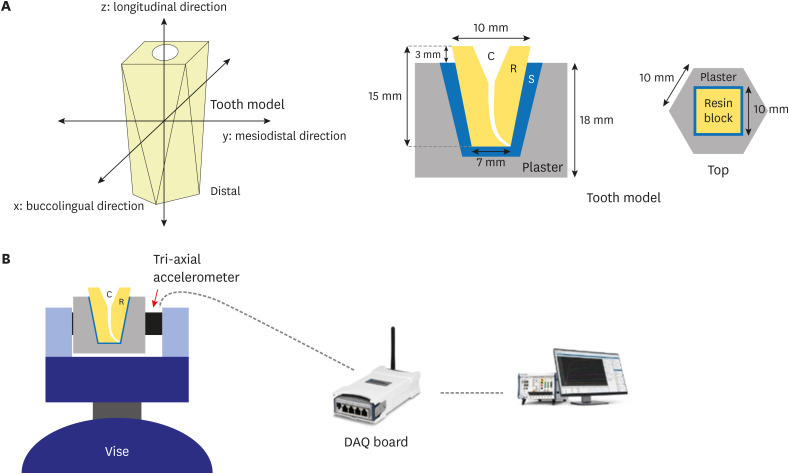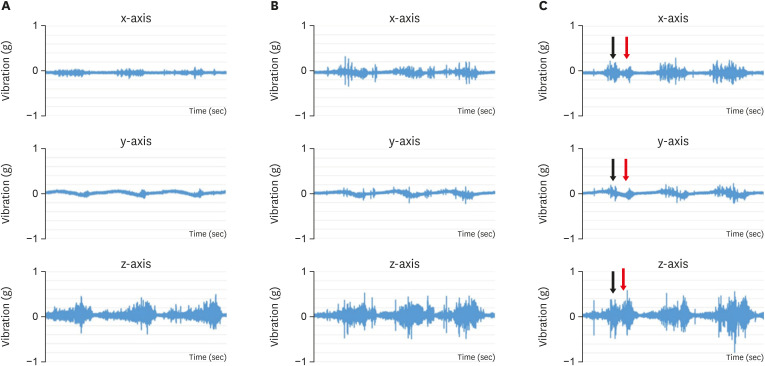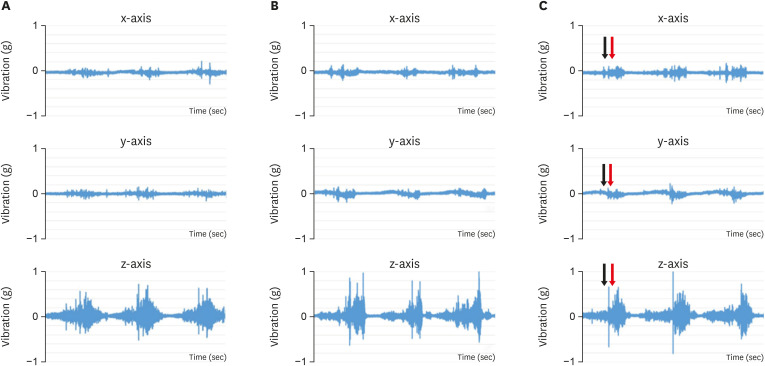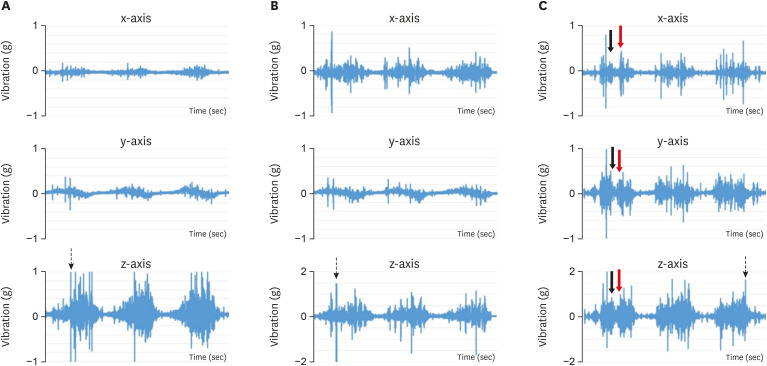INTRODUCTION
Numerous file systems for root canal shaping have been introduced to date, and despite differences in the design and mode of motion, all share the functions of effectively removing tissue from the root canal, facilitating the discharge of debris, and reducing the risk of instrument separation [
12]. Recent advances have yielded instruments that are produced with new heat treatment methods and that operate using modes of motion other than conventional continuous rotary motion, and these instruments have high cutting efficiency and fracture resistance [
34]. File systems produced using new heat treatment methods are typically classified as gold alloy file systems, and these include the ProTaper Gold (PTG; Dentsply Maillefer, Ballaigues, Switzerland) and WaveOne Gold (WOG; Dentsply Maillefer) file systems. The files in these systems are more flexible than conventional files, allowing for their use in curved root canals with minimal distortion of the root canal shape and high fracture resistance [
567].
One form of rotary motion other than conventional continuous rotary motion is reciprocating motion, and representative file systems that use this type of motion include WOG and Reciproc Blue (VDW, Munich, Germany). A continuous rotary file rotates 360° in a single cyclic motion, which exerts a significant amount of stress on the file. In contrast, a reciprocating file uses at least 3 cycles to rotate 360°, which offers the advantages of excellent fracture resistance due to the smaller amount of stress exerted on the file [
8], cutting efficiency superior to conventional continuous rotary motion, and minimal distortion of the root canal shape [
9].
However, the first study of vibrations generated during root canal shaping using nickel-titanium (Ni-Ti) files reported that reciprocating Ni-Ti files generated stronger vibrations than conventional rotary files; thus, vibrations could be an unavoidable disadvantage of reciprocating motion [
10]. These vibrations may cause discomfort, especially in periodontally involved teeth with increased mobility [
11]. In addition, the sound produced by these vibrations can cause anxiety for patients [
12].
While previous studies compared vibrations across different modes of motion with consistent file length, no studies have been conducted on the differences in vibrations according to file length. Accordingly, the objective of the present study was to compare the vibration characteristics of Ni-Ti file systems for root canal shaping across different file lengths, while also considering differences in the mode of motion and cross-sectional morphology.
MATERIALS AND METHODS
Materials
A total of 45 J-shaped resin blocks (Endo Training Bloc-J, Dentsply Maillefer) were trimmed into a root-shaped form to resemble natural teeth. The root area of the trimmed resin block was wrapped with aluminum foil to a thickness of 1 mm, and the foil was fixed to the plaster to simulate the alveolar bone. After the plaster hardened and the resin block was removed, the aluminum foil wrap was detached, and the space created between the resin block and the plaster was filled with silicone impression material (Examixfine, GC, Tokyo, Japan) with a thickness of 1 mm to simulate the periodontal ligament (
Figure 1A).
Figure 1
(A) A schematic drawing of the 3 axes of the accelerometer and the tooth model. (B) A schematic drawing of the tooth model and testing apparatus.
C, root canal; R, resin block; S, silicone impression material; DAQ, data acquisition.

A triaxial ICP accelerometer (Model 356A12, PCB Piezotronics, Depew, NY, USA) was used to measure the vibrations. The accelerometer was clamped to the tooth model by a vice to minimize interference caused by external vibration (
Figure 1B).
Methods
The tooth models were divided into 3 experimental groups: PTG, ProTaper Next (PTN; Dentsply Maillefer), and WOG (n = 15 each). Subsequently, each experimental group was divided into 3 subgroups according to file length: 21 mm, 25 mm, and 31 mm (n = 5 each). An X-Smart Plus (Dentsply Maillefer) electric endodontic motor, which can operate using both forms of rotary motion, was used for the shaping procedure, and physiological saline was used as the root canal cleaning solution.
First, a size 15 K-file was used to measure the working length on the tooth model held by the vice. The working length was set at 16 mm. Subsequently, PTG (SX-S1-S2-F1-F2), PTN (X1-X2), and WOG (small/primary) files were used in accordance with the manufacturer's protocol for root canal shaping. During each step of the shaping process, physiological saline was used to irrigate the root canal. The final file size for each system was set at a size 25, and the vibrations generated when using a size 25 file were measured. The experiment was carried out using the “ProTaper Gold” mode of the X-Smart Plus device for PTG, the “ProTaper Next” mode for PTN, and the “WaveOne Gold All” mode for WOG.
The distal aspect of the tooth model was set as the apical direction of the simulated canal, and an accelerator was attached to the distal surface to measure vibrations generated in the buccolingual direction (as reflected by the x-axis), the mesiodistal direction (reflected by the y-axis), and the longitudinal direction (reflected by the z-axis) (
Figure 1A). The vibrations experienced during 5 consecutive pecking motions required to reach the working length were measured. The vibrations were transmitted to a computer through a data acquisition board (National Instruments, Austin, TX, USA), and the values were measured and displayed graphically using the NI Sound and Vibration Assistant 2009 software program (National Instruments) (
Figure 1B). Each vibration was measured as a vector value relative to each axis, and the measured values were used to calculate the average vibration acceleration. A single endodontist performed all root canal shaping procedures, and a new file was used for each tooth model.
Statistical analysis
FSPSS version 22.0 (IBM Corp., Armonk, NY, USA) was used to analyze the differences in average vibration acceleration between the experimental groups via 1-way analysis of variance and the Scheffé post hoc test with a 95% confidence interval.
DISCUSSION
Processes that involve using a drill to create holes include drilling, boring, reaming, and tapping. Boring refers to the process of finishing the inner surface or widening a hole that has been created [
13]. Root canal shaping, which involves widening the root canal while cutting along the canal and evenly trimming the inner surface, can be viewed as a form of boring. Increases in the length/cross-section ratio of the boring bur can cause increased flexibility and vibrations, which can degrade the quality of the cutting surface [
1415]. The findings of the present study also showed that vibrations tended to increase at longer file lengths. PTG showed significantly greater vibration acceleration with 31-mm files than with 21-mm files, while WOG showed significantly greater vibration acceleration with 31-mm files than with 21- or 25-mm files. PTN showed no significant differences among the file lengths. PTN is made with M-wire, the main component of which is the austenitic phase of the Ni-Ti alloy. The other 2 file systems are gold heat-treated file systems with the martensitic phase as the main component. Typically, the martensitic phase has greater flexibility than the austenite phase [
16]. This may explain why PTN was less affected by the increase in length than the other 2 file systems, but additional experiments on this topic are needed.
In a previous study, torsional resistance was compared across different file lengths (21, 25, and 31 mm) [
17]. The results of that study indicated that instruments with longer shafts may have higher maximum torsional loads or toughness than those with shorter shafts. The changes in these properties according to file length may have affected the vibration pattern. However, further research on this topic is needed.
A previous study in which experiments were conducted using the PTN file system [
11] reported an average vibration acceleration of 0.106 ×
g, but the measured result in the present study was 0.075 ×
g despite using the same engine. This difference between studies may be attributed to differences related to the operators who carried out the experiments and to errors during the experimental tooth model creation process. The higher average vibration acceleration found when using the reciprocating file system is consistent with the findings of a previous study [
11]. Large vibrations were generated when the direction of rotation changed during reciprocating motion (
Figure 4), which contributed to the differences versus the 2 other file systems [
1011].
Differences in vibrations were also found between the 2 file systems that utilized continuous rotary motion, with PTG showing greater vibration acceleration. PTG has a triangular cross-section, while the cross-section of PTN is rectangular. While PTG cuts, 3 cutting angles are in contact with the root canal wall as the file rotates, whereas for PTN, only 2 of the 4 cutting angles come into contact with the wall because its axis of rotation is not in the center of the file [
18]. Force is transmitted when the file contacts the root canal wall and vibrations are generated. Therefore, PTG, with its greater degree of contact, would be expected to generate stronger vibrations.
Comparison of the taper range of D0 to D3 showed a larger taper for PTG, with tapers of 0.07 and 0.06 for PTG and PTN, respectively. It is suspected that the PTG files were associated with greater vibration acceleration because the cutting force increases when cutting at a greater depth, generating stronger vibrations [
19].
WOG has a unique alternating offset and transitioning parallelogram-shaped cross-section, which limits the engagement between the file and the dentin [
20]. Despite this fact, WOG generated more intense vibrations than the other file systems because it generated intense vibrations at points where the direction of rotation changed, as previously mentioned.
With regard to axis, regardless of the file type or length, the largest to the smallest vibrations were observed in the z-, x-, and y-axes, respectively (
Table 2). The z-axis reflected vibrations along the longitudinal axis, and it is believed that the largest vibrations were measured along the z-axis because this axis may have been most strongly affected by vertical force due to the pecking motion of the operator. The x-axis was set in the buccolingual direction, and relatively large vibrations may have been measured along this axis due to the presence of less holding force on the tooth model than in the mesiodistal direction, which was firmly held by the vice. The finding that WOG showed significantly more intense vibrations in the z-axis than the other file systems, regardless of file length, may be attributed to the greater vertical force exerted when using reciprocating motion compared to continuous rotary motion [
21].
In the vibration graphs for each axis, WOG showed intense vibrations at the points where the direction of rotation changed, and this characteristic became more prominent as the file length increased (
Figure 4). It is believed that the increase in file length resulted in increased flexibility; as a result, stronger vibrations were generated with the same motion, and even stronger vibrations were generated at the points where the direction of rotation changed. The y-axis (the mesiodistal direction) exhibited gradually increasing vibrations as the file approached into the root canal, followed by decreasing vibrations and then increasing vibrations again (
Figures 2,
3,
4). This pattern was likely due to greater force being exerted on the file as it moved through the curved part of the root canal, with the vibrations then decreasing after it passes beyond the curved part. Subsequently, as the file was retracted, it passed through the curved part again, which caused the vibrations to increase again.
In the present study, experiments were conducted on tooth models to observe the vibration patterns according to the length of the Ni-Ti file for root canal shaping. To simulate conditions similar to clinical settings, rubber impression material and plaster were used to reproduce the periodontal ligament and alveolar bone in the tooth models. However, these models still differed structurally from actual teeth, and this study also had the limitations of not considering tooth position, such as maxillary/mandibular anterior and posterior teeth and single- versus multi-rooted teeth. Therefore, in the future, it is necessary to consider methods that could measure vibrations generated during root canal treatment in patients.
The findings in the present study showed that stronger vibrations appeared as the file length increased. Therefore, practitioners should consider using files that are as short as possible in clinical practice. A common finding between the present and previous studies [
1011] was that more intense vibrations were generated during reciprocating motion than during continuous rotary motion. Accordingly, caution should be taken when using a reciprocating file system.










 PDF
PDF Citation
Citation Print
Print



 XML Download
XML Download